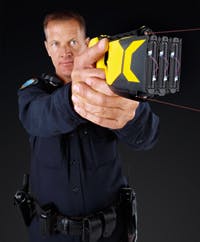The list of what an officer needs to carry on patrol is long; this creates not only a burden on his physical and duty belt real estate, but is also weighty on a department's budget. What may have once been considered a duty gear luxury, less-lethal tools help officers bridge the use of force gap between batons and firearms. One such tool is the Taser electronic control device (ECD).
"I think they're a very, very effective tool. If you went across our agency and talked to the different officers with the varying degrees of experience ... everyone is pretty much in agreement that it's one of the best tools to come along in law enforcement in a long time," Officer Frank Bissette says. "[ECDs] have brought that level of safety up."
But with budgets leaner than anyone ever thought possible, where does the department find money to update any technology? One southern department has found a way to get the upgrade it needed and benefit its public safety neighbors at the same time.
Dollars & sense
Last year, the Dothan Police Department decided it was time to outfit its entire fleet with the latest version of Taser's single-unit ECD, the X26. Previously, the Alabama police department's less-lethal ECD population was mostly made up of M26 units. The M26 version, which began sale to law enforcement in the late '90s, is a bit bulkier, somewhat outdated generation of the technology compared to X26 Tasers. At one point Dothan PD was able to get its hands on a few X26s, but the bulk of the sworn Dothan officers continued to carry the M26, which was bulkier and becoming more expensive to maintain.
"When you've got a device that costs $400 brand new and it costs that much to repair it, it becomes not cost effective," Bissette, a 21-year retired military vet and current sworn officer with Dothan PD, explains.
When Bissette retired from the military he joined DPD full-time. As part of his responsibilities, he handles all issues related to training and also equipment purchase. Though the department has 165 sworn positions, Bissette says initially only student resource officers and supervisors were carrying the X26 Taser ECDs.
Last year, Bissette says DPD and the City made the decision to buy the X26 for the entire department. Several factors influenced this decision, he says, including the desire for a smaller-sized model and considering that Taser is phasing out the older M26 technology.
With the new devices in place, the department had 110 M26 units it no longer needed. That's when Bissette says he began researching what he could do with the spare Tasers.
"Dothan is the largest department in this part of Alabama -- in the Southeastern corner of Alabama -- and we have a lot of smaller ... municipal departments and communities that surround our area. We decided to go ahead and let them buy the Tasers at a much reduced price to better facilitate equipping them," he says.
Surprisingly, Taser believes this is a great plan. The company would like to see all agencies update their equipment, however Steve Tuttle, spokesman for Taser, says it's just not feasible for many departments right now. Instead, Tuttle finds this method of updating, and passing that technological on down, a smart system.
"That's not seen in a negative way at all. I think [buying and selling second-hand Tasers] is just being clever," Tuttle says. "You know, a lot of agencies just destroy these things -- or they return them for the credit, hopefully -- but that way good technology is still going to good use, and I think that's respectable."
The Taser toolbox
For law enforcement, Taser has several offerings, the eldest of which for police is the M26.
Tuttle notes the differences between Taser's M26 and X26 devices, emphasizing that the M26 is aged technologically. M26 devices have been available since 1999, with updates and tweaks taking place between then and when the X26 unit was released in 2003. Tuttle compares the electronic development to another portable everyday unit, the cellular phone. "They are like cell phones; they get beaten up," Tuttle says. "It's a great analogy; you do get quite an advantage with a 2010 cell phone versus something that was designed in 1999."
Since its debut in 1999, the M26 has been followed up with the X26, a 60-percent lighter model, then with the X3 in 2009, which Taser claims can simultaneously incapacitate up to three subjects. The latest piece of tech from Taser is a self-contained 12-gauge shotgun round, the extended range electronic projectile or XREP, which is a wireless ECD that deploys from a shotgun. The XREP is released in conjunction with a special less-lethal system that Taser and Mossberg call a "less-lethal shotgun," a Mossberg 500 pump-action shotgun retooled to project the XREP less-lethal round.
Prices vary between units but begin at around $815 for the X26; $600 for the X12 shotgun and $750 for a box of 5 XREPs; and approximately $1,700 for an X3 triple-ECD discharge system.
An obstacle
Local Dothan officials were apprehensive about the second-hand sale proposal. Concerns were raised about how the department might be liable once the used Tasers were at work with another agency. Bissette says some of the fears stemmed simply from outside misunderstanding about Taser technology, which he easily cleared up with facts and figures on the ECD. To be sure DPD had all its bases covered, he also says he gave the Taser legal department a call. He learned that as long as he had the buying agency sign a liability release document -- also called a "hold harmless" agreement -- the department was not on the hook for any legal responsibility, which helped give the green light to put the surplus older models up for purchase.
The department decided to divvy some of the units up amongst its affiliate security agents, such as the non-sworn police auxiliary team, nearby Dothan Regional Airport agents, and the animal control team, for example. After those contributions, DPD had approximately 70 units to sell for $100 each to qualified law enforcement agencies, with a total possible intake of $7,000. Though the income from the second-hand sales would not directly go toward the new purchase; the money was placed into the city fund, which is where the agency draws its budget.
Added benefits
Dothan Police didn't get rich off the sale; however, multiple benefits were borne from the second-hand sale plan.
Originally for the 110 M26 units that were purchased in 2003, DPD spent approximately $44,000, which leaves a rather large gap after figuring in the nearly $5,500 recouped so far from sales, but does amount to an approximate 25-percent return for each unit sold. Working with that same equation, buying agencies were able to save $300 off the cost of an M26, which initially retailed for $400. That's a rollover that adds up quickly when a handful of units are acquired. The cost break also benefits departments that may not have the ability to purchase this kind of less-lethal tool, and multiplies the number of officers equipped with Tasers.
Bissette says that though neighboring agencies are now carrying the older M26 units, the department still benefits from them. The tools come in handy during mutual aid for emergencies or multi-agency response, such as during a disaster.
Bissette says there is not any maintenance or refurbishing procedure for the units they sell or donate second-hand. He explains the ECDs are function checked, operational and sold in as-is condition. The department also has receiving agencies sign the "hold harmless" document which releases Dothan from any liability relating to the equipment once it's owned and in use by another law enforcement agency. The cartridges from the M26 models, the older units Dothan is selling, will work on the newer and now-deployed X26s, but no other accessories were retained by the department. Holsters were included in the sale but no cartridges, batteries or chargers.
Equip with less-lethal for less
X26s have been used by the department supervisors since 2003; in 2009 the entire sworn population was outfitted with an X26 unit. Now every officer is assigned an X26 Taser device and once qualified, carries it full time. In early August the units were on patrol with officers -- as is the case every day Bissette says -- during National Night Out in Dothan.
While some agencies are finding the budget dollars to renew their Tasers, other agencies can benefit from their neighbor's upgrade.
Though Taser finds the move to sell second-hand units clever, Tuttle confirms the M26 will retire soon. "Frankly, this is the end of life for the M26: we just can't keep buying these components," Tuttle says. "[These older components are] harder to find and the warranties have expired. So it really makes sense economically to upgrade."
One southern department has found a way to get the upgrade it needed and benefit its public safety neighbors at the same time. For an industry where budgets are not commonly spilling over with excess (even during a good year), agencies can really benefit from programs for rebate or refurbished tech that can result in a funding solution.
Regional Taser Sales Rep Brian Black, who's been working with the company and assisting agencies for seven years, says he's seen similar kind of aid programs take place over the years. "It's actually kind of heartwarming when you hear about those because you know that the community really wants them," Black says. "If [the agency] can't afford them, it's great when the community steps up to really help them out."

Tabatha Wethal | Editor
Award-winning writer Tabatha Wethal is a previous editor leading Law Enforcement Technology magazine and assisted with other publications. She was with the magazines since 2007.



